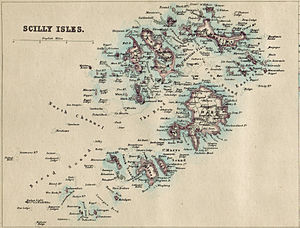Bishop Rock
| Bishop Rock | ||
|---|---|---|
| Bishop Rock Lighthouse (2005) | ||
| Waters | Celtic sea | |
| Archipelago | Isles of Scilly | |
| Geographical location | 49 ° 52 '22.3 " N , 6 ° 26' 44.1" W | |
|
|
||
| length | 46 m | |
| width | 16 m | |
| surface | 0.06 ha | |
| Residents | uninhabited | |
| The Isles of Scilly on an 1874 map. Bishop Rock is in the extreme southwest | ||
Bishop Rock ( Cornish : Men at Eskob ) is a cliff of the front of the entrance Channel lying Isles of Scilly . On the United Kingdom belonging to rock the same 49-meter-high stands lighthouse , that of the English Beacon Management Trinity House is operated. The in 44 meters above mean sea level of the Celtic Sea lying beacon with a strength of 60,000 candela has a range of approximately 20 nautical miles (37 km).
In the Guinness Book of Records Bishop Rock is the smallest built-up island recorded the world.
history
In 1847 the construction of the first tower began on the rock lying 4 nautical miles west of the inhabited Isles of Scilly, which was washed away by a storm on February 5, 1850, except for a few steel foundation girders before the completion of the light house. Over the next two years, steel connectors made of granite blocks weighing one to two tons were used to build a 14 m high solid foundation with a diameter of 10 meters. In the following six years, a total of 2,500 tons of granite were used for the 35 meter high tower. The cost was £ 34,560 ( pound sterling ), which is approximately £ 3,600,000 today, adjusted for inflation ; (at the current exchange rate: 4 million euros).
On September 1, 1858, the beacon could start operating. An inspection in 1881 found serious damage to the structure of the foundation. Since the height of the fire was to be increased by 12 meters, the base was then reinforced with granite blocks anchored with heavy bolts, which were also used for the additional covering of the tower base to protect the tower from the surf . A further 3,200 tons were used for the work, which increased the total weight of the structure to 5,700 tons. The work, which was completed in October 1887, cost £ 66,000 (equivalent to £ 7,300,000 today or EUR 8.2 million at the current exchange rate).
The lighting was switched from light kerosene to electrical energy in 1973. The helipad on the top was built in 1976. Bishop Rock was the last manned lighthouse in South West England . After installing remote monitoring, the beacon keeper left the tower on December 21, 1992.
Nautical facilities
Next to the beacon, which flashes every 15 seconds, is Great Britain's radar beacon No. 1. Until June 2007, when visibility was poor, a fog horn also sent the letter N as a sound signal in Morse code every 90 seconds .
Accidents
On May 7, 1875, one of the worst shipping accidents in British history occurred near the rock. The sailing steamer Schiller ran aground due to a navigation error on the Retarrier Ledges. There were 335 dead; only 37 people were able to save themselves.
See also
literature
- Bishop Rock lighthouse - lonely bastion against the forces of nature . In: Leuchtfeuer No. 72, pp. 28–36, Klaus Kern (ed.), Rüsselsheim 2015
Web links
- Bishop Rock Lighthouse. Trinity House , accessed September 1, 2016 .
Remarks
- ↑ a b This figure was based on the template: Inflation determined, rounded to a full £ 10,000 and relates to last January.
- ↑ a b This figure was determined using the template: Exchange rate data / ECB .


